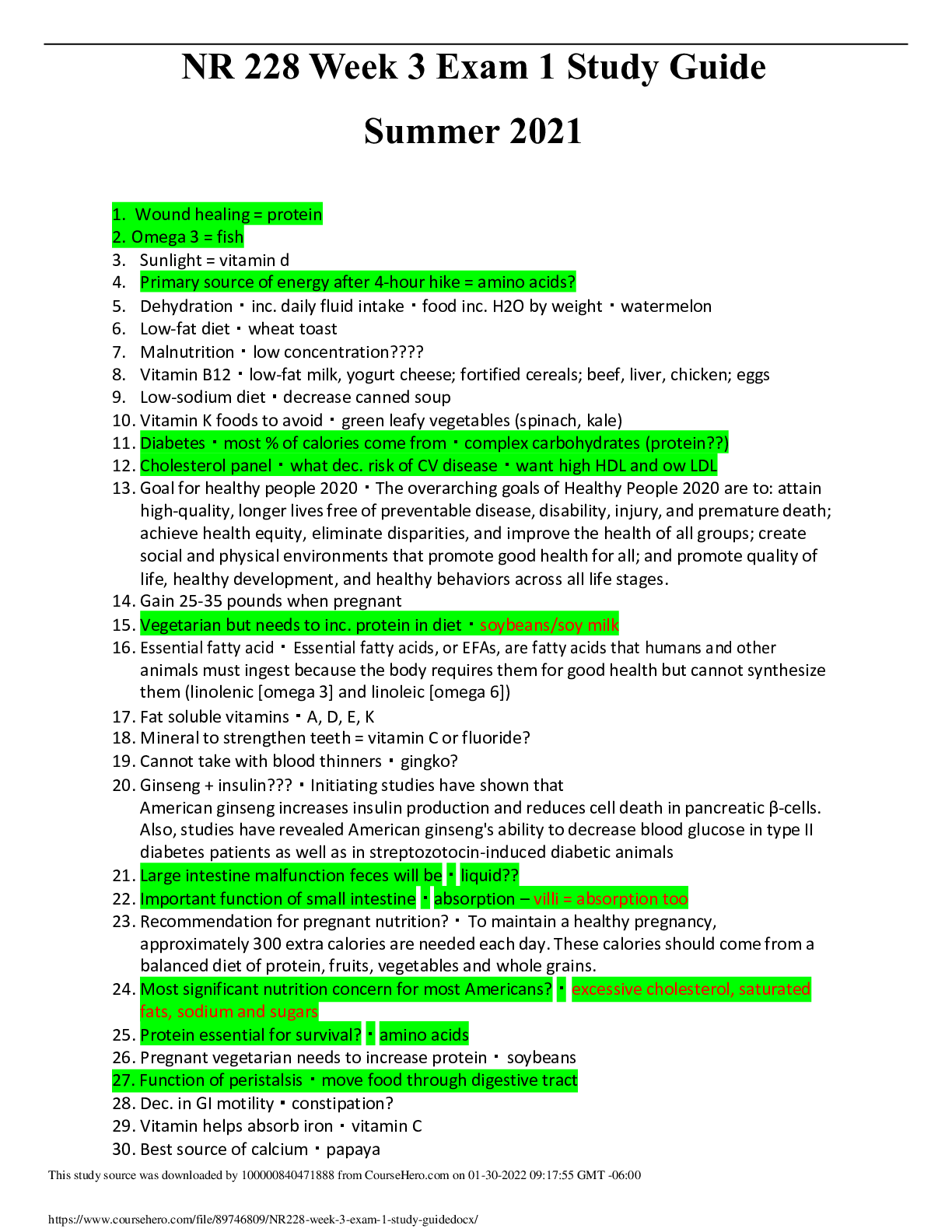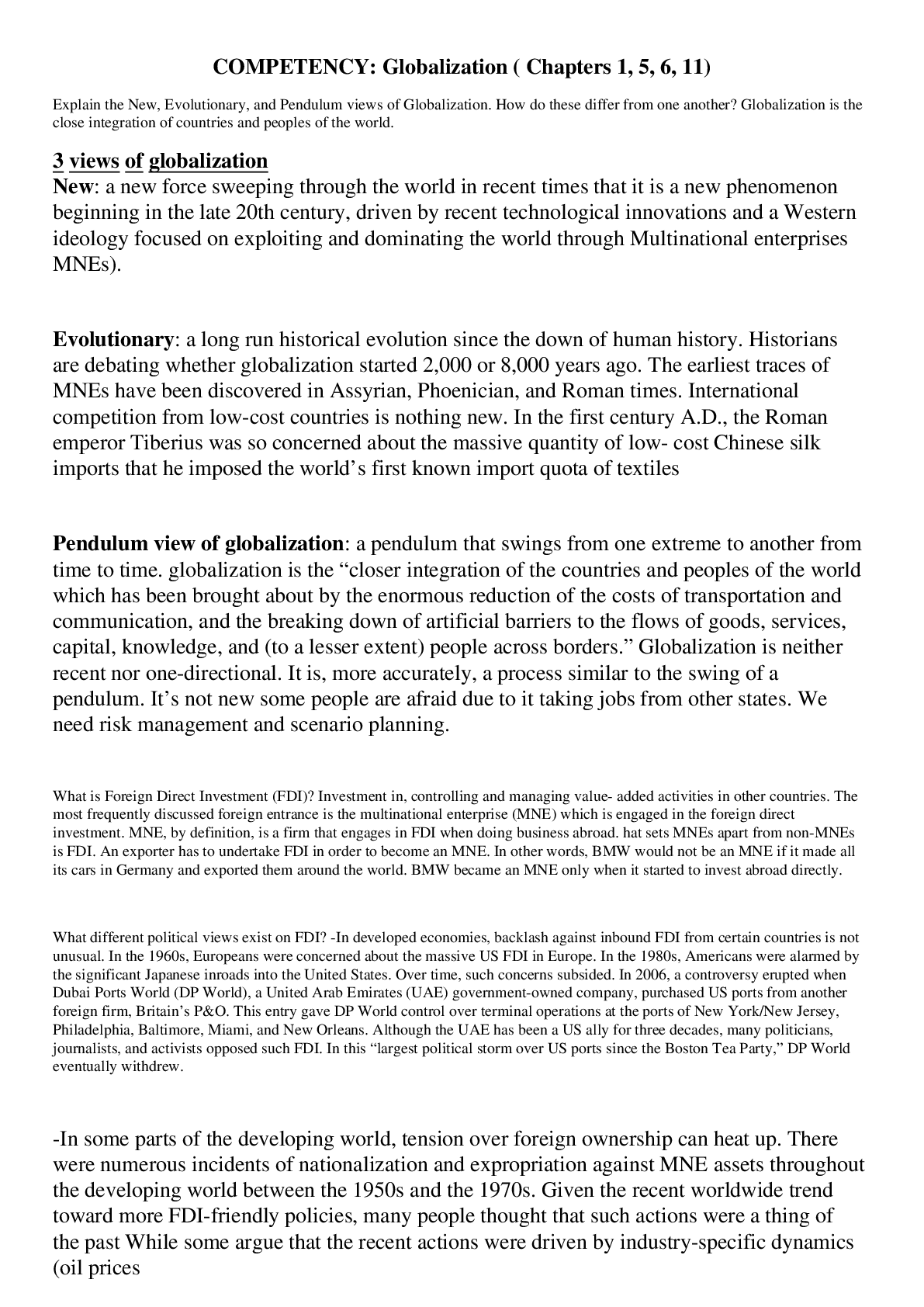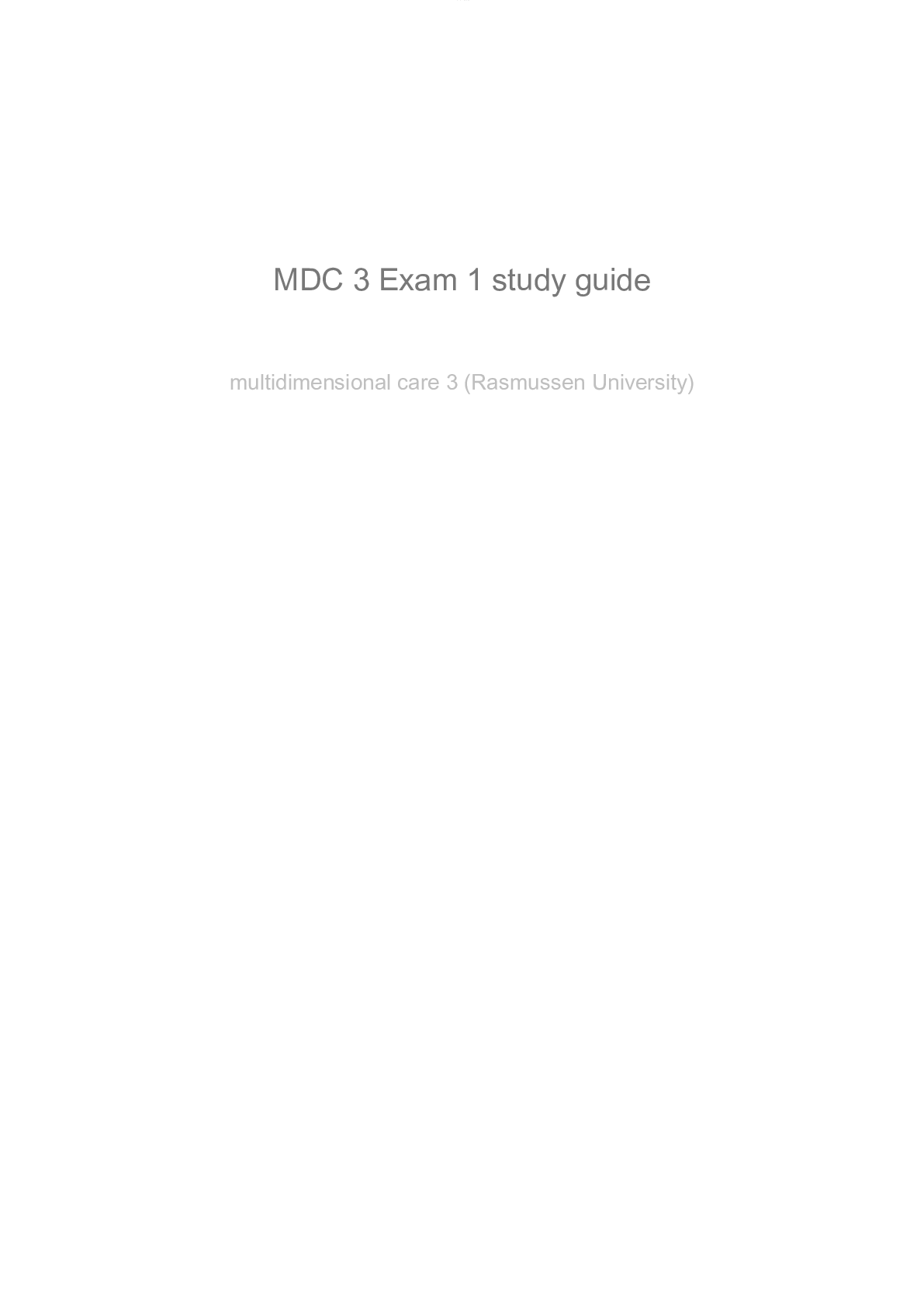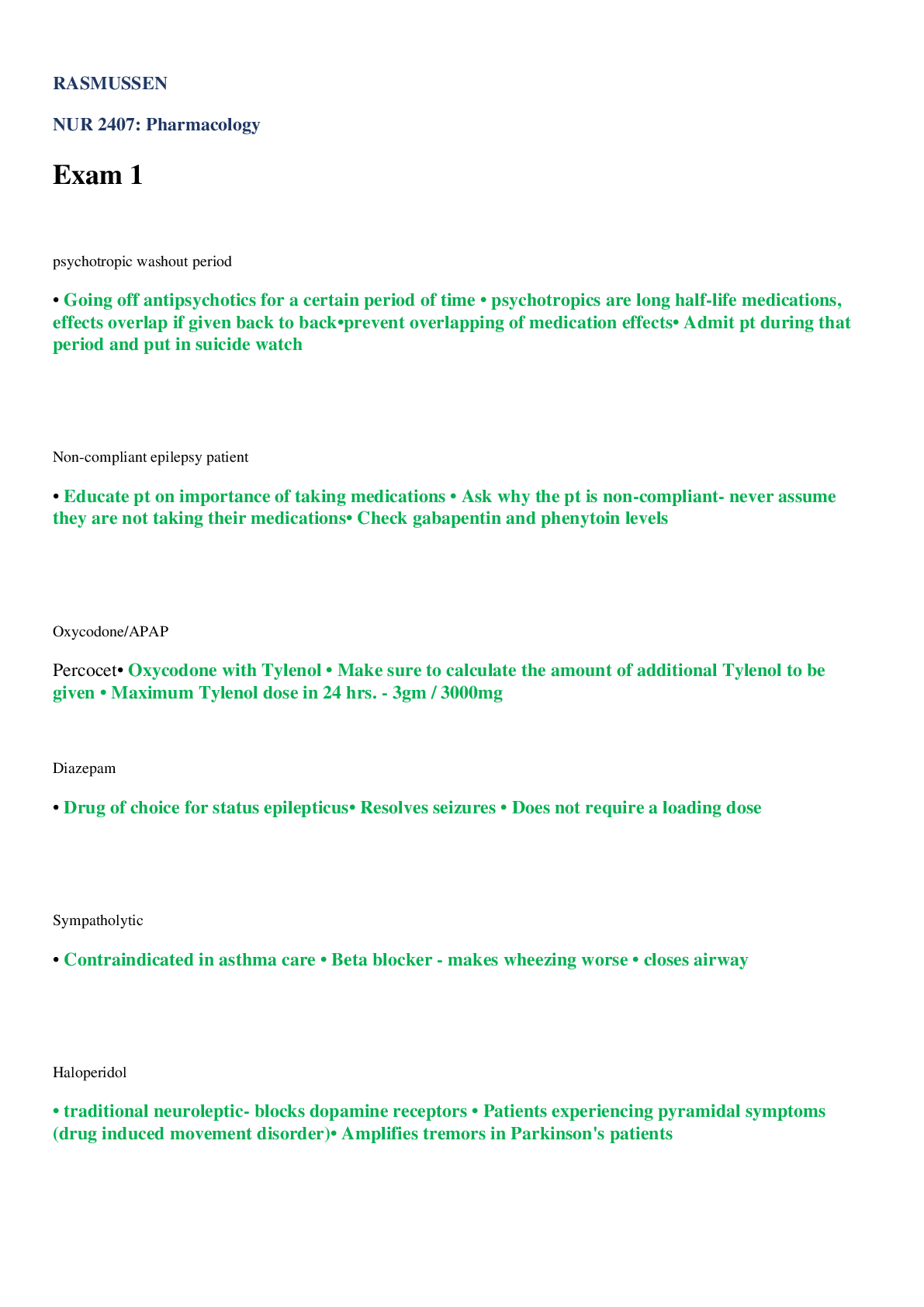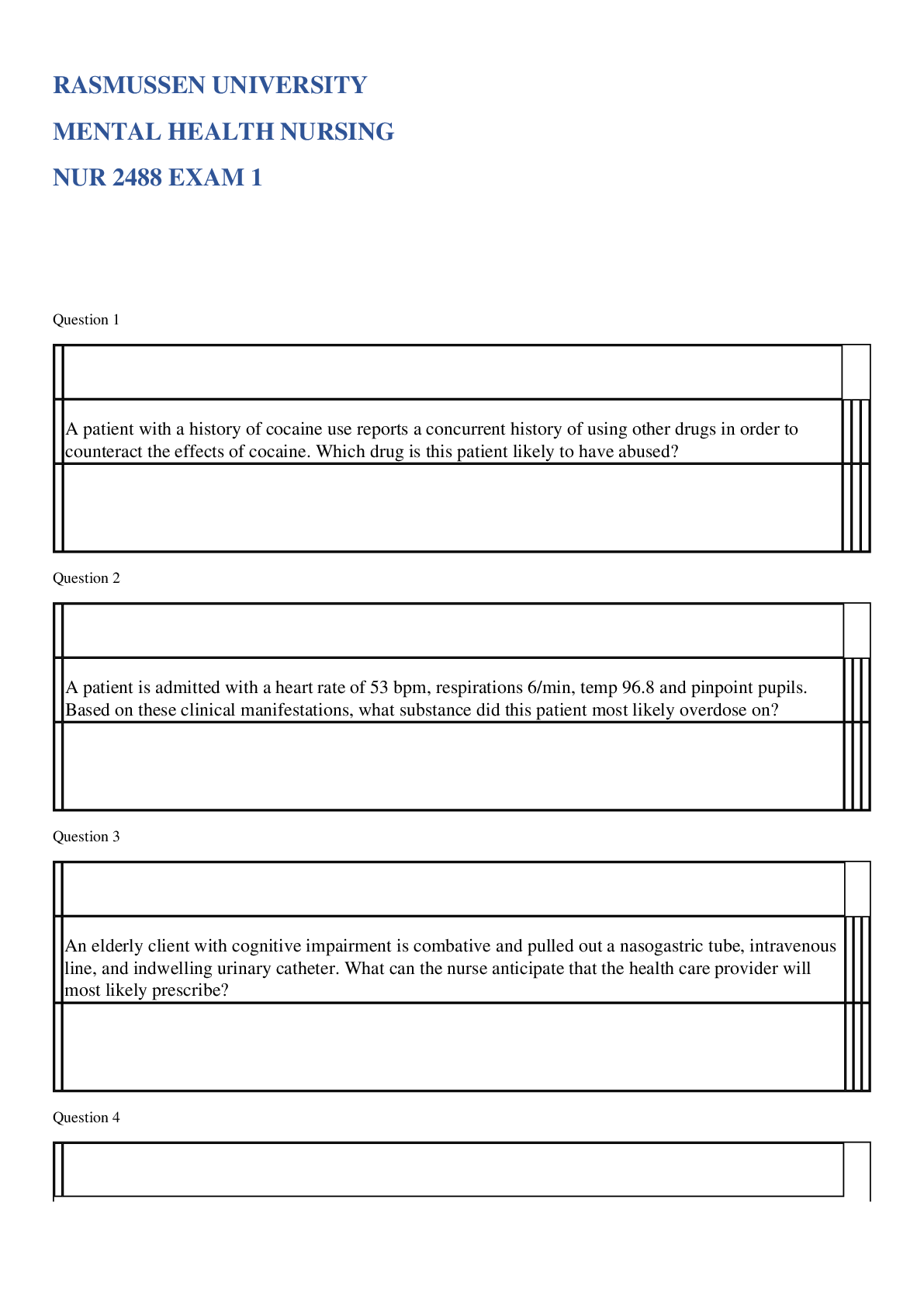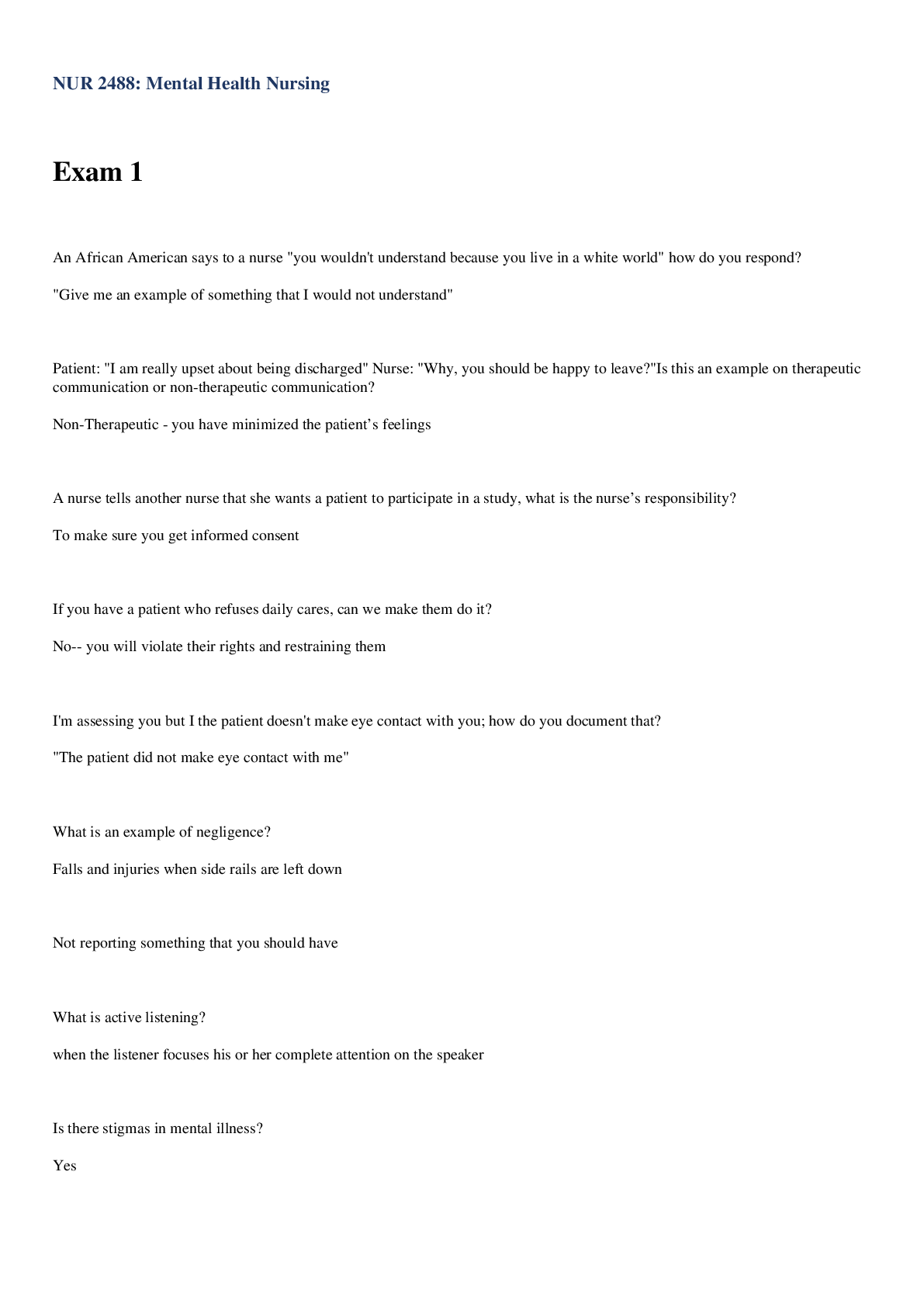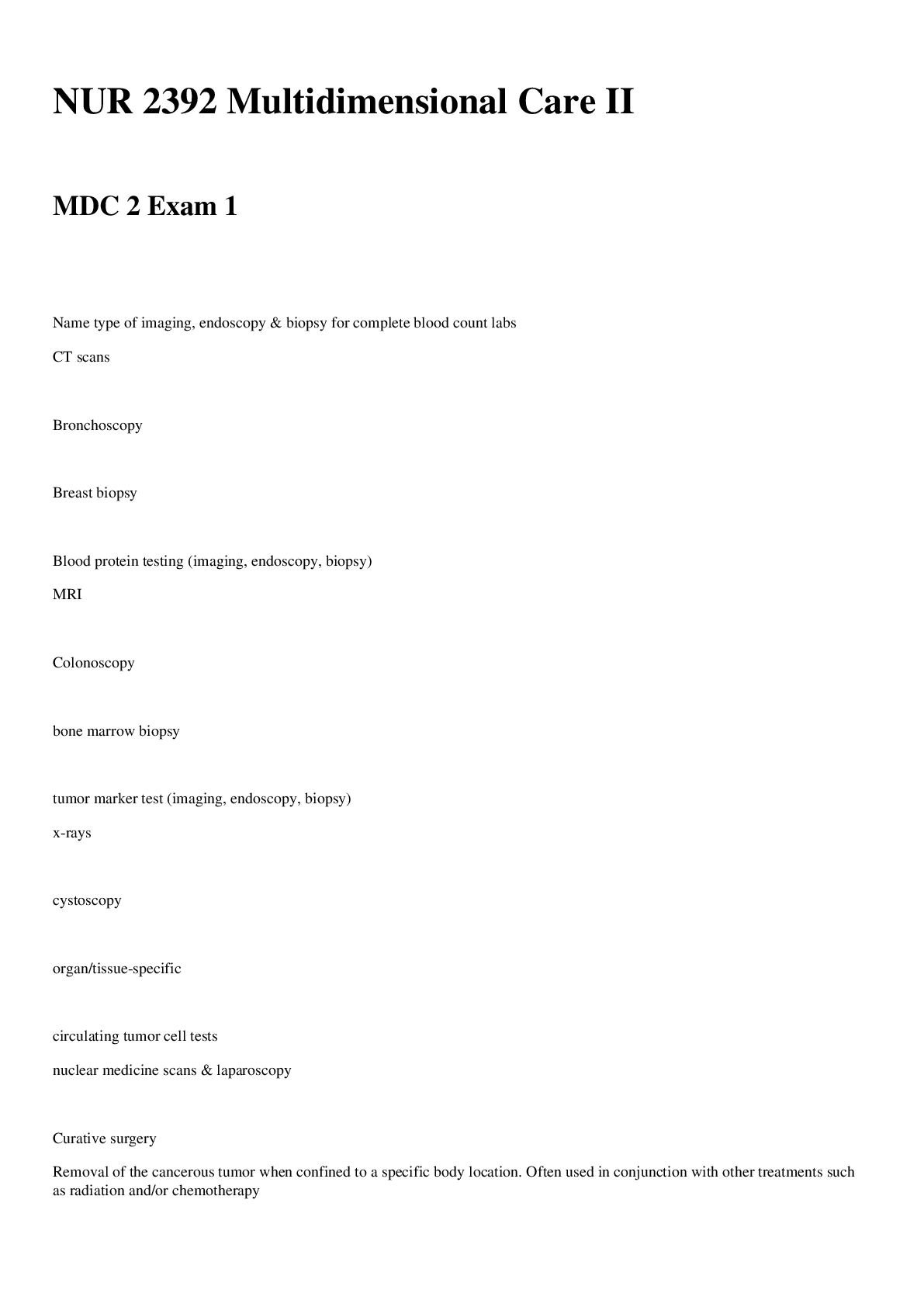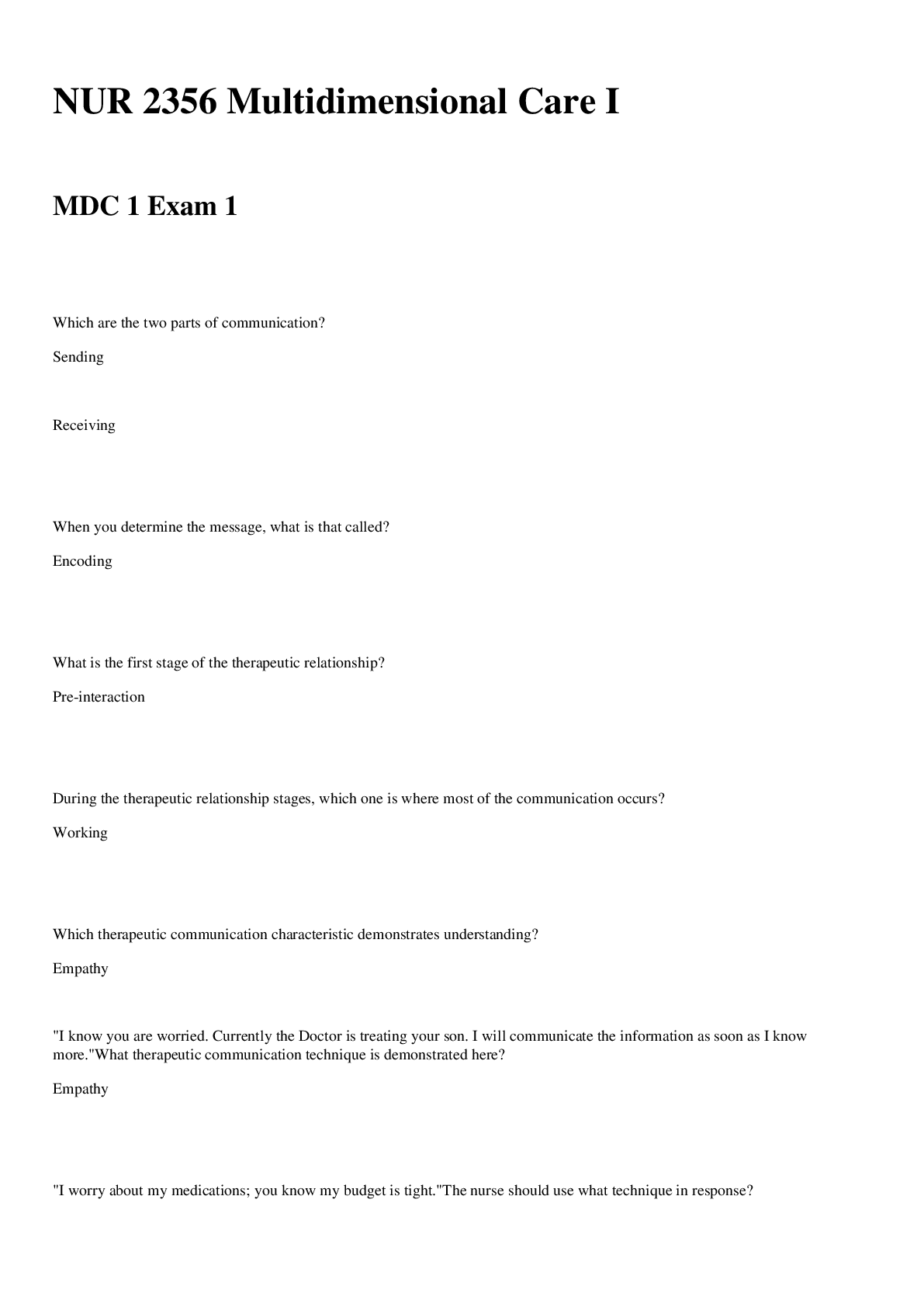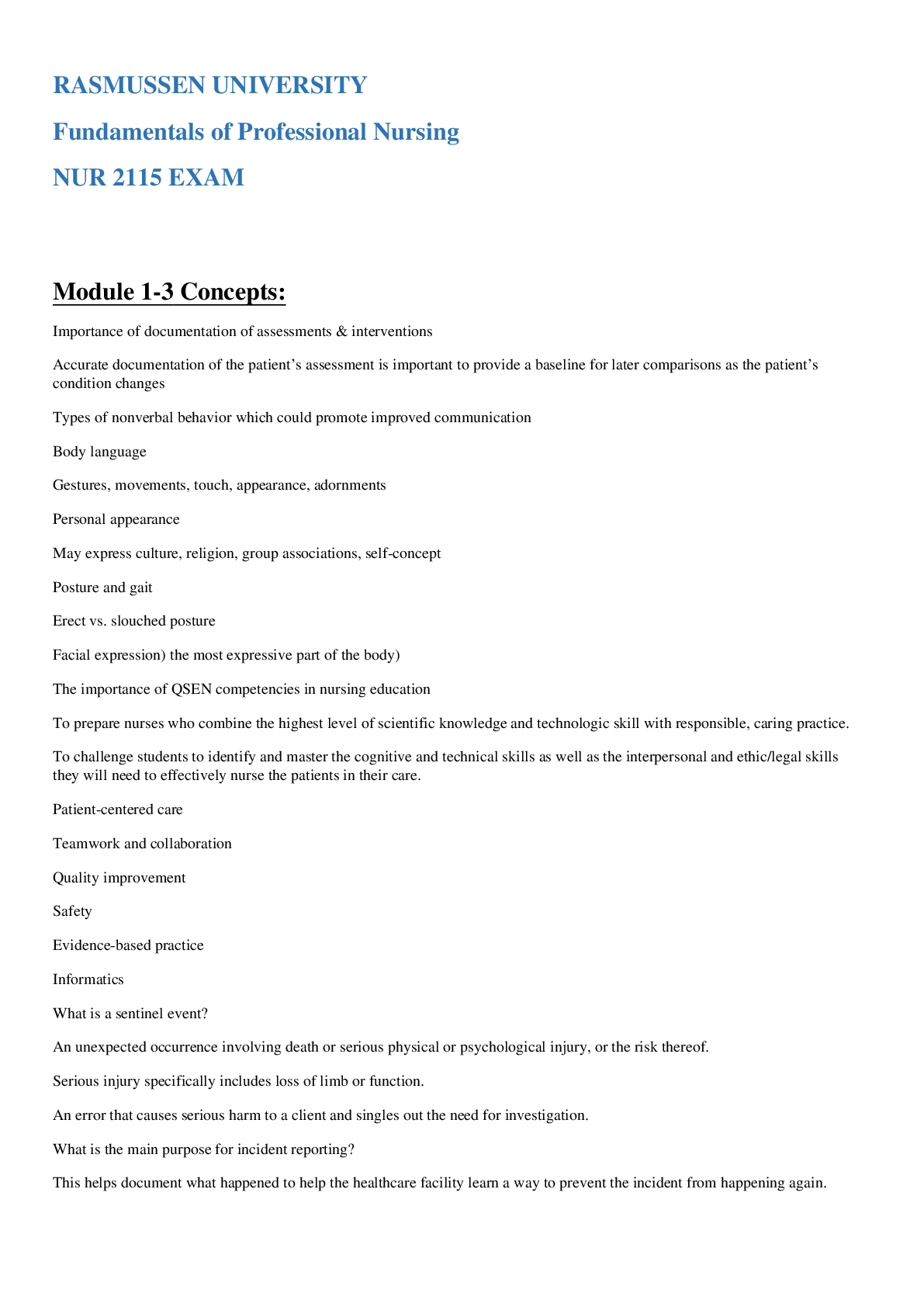N340 Week 1 Study Guide Exam 1 Latest 2022/2023,100% CORRECT
Document Content and Description Below
N340 Week 1 Study Guide Exam 1 Latest 2022/2023 Chapter 1 Renewed interest public health and in population focused health care in the United States – especially with nurses & epidemiologist wi... th the epidemic Population-focused approach: where we assess the community – understanding the most vulnerable people = homeless population Prevention emphasis: many factors influence the lack of prevention – start looking at who the decision makers are and what information they are using to make decisions and what their backgrounds are in regarding their decision making Community-based nursing • Focus is on illness care of individuals and families across the life span – try to remedy the s/s of an individual or • The concern and focus is the growing cost of hospital care and how the services are being rendered Community-oriented nursing • Focus is to look at both the healthcare of community/ population AND health care of individual, families, and groups – promoting quality of life and helath care of entire community • Includes the specialty of public health nursing • The goal: to prevent disease and preserve, promote, restore, and protect health for the community and the population within it Public health: the goal is to organize community efforts that will use scientific and technical knowledge to prevent disease and promote health • It’s a scientific discipline – that includes study of epidemiology, statistics, assessment • Pays attention to behavioral, cultural, and economic factors, program planning, policy development • Members of a society do collectively to ensure conditions exist in which people can be healthy Benefits of public health • Increase in life expectancy • Decreased # of deaths from stroke, coronary heart disease, and cancer • Decline in death rates of adults and children • Population focused PH approaches can prevent up to 70% of early deaths, compared to only 10% for medical o Doing preventative measures is very beneficial Solid history of preventive improvement • Life expectancy in the 1900s went from less than 50 to 77.9 years by the year 2007 o This has been credited due to sanitation, control of infectious diseases through immunizations • The US public health service estimates the use of medical treatment can prevent about about 10% of all early deaths • We need to shift the focus of individual care to preventative measures – we tend to operate on reactive measures such as waiting for dx to be established rather than try to prevent it • Typically a hospital will operate for a pt to be sick first then treat the pt – as opposed to wanting to prevent the dx PH Core Functions: • Assessment: systematic data collection on population, monitory population health status and making the • Policy development: efforts to develop policies that support the health of the populations including using scientific knowledgeable to make policy decisions • Assurance: making sure essential community orientated health services are included – providing essential personal for health services of individuals as well as competent public health work force • ** you will see references to APA = assessment, policy development, assurance • Research – we are constant looking for the most up to date evidence to create policies and to ensure we are providing competent health care work force ASSESSMENT • Participate in and provide leadership for the following: o Look at trends in health determinants o Identify priority health needs o Determine the adequacy of existing resources within the community o Engage in policy-development efforts o Assessing community needs, health status of populations within the community, and environmental and behavioral risks • We are conducting an assessment but still engaging in policy development efforts POLICY DEVELOPMENT • Core function and care intervention strategy • Seeks to builds constituency for change in public policy • Ex: development of Healthy People 2020 state objectives (objectives are looked at q10 years), national effort to control acquired immunodeficiency syndrome (AIDS), antismoking ordinances • Education, empowering people about environmental health issues, mobilizing community partnerships, actions to identify and solve public health problems, develop policies and plans that support individual and community environmental health efforts ASSURANCE • Ensure that activities meet pubic health goals and plans • Develop partnerships between public and private agencies • Promote knowledge and behaviors that support and improve public health • We ensure a competent workforce and resources • Look at regulations the ensure public health, ensure safety, evaluate effectiveness and accessibility and quality of personal and population based environmental health service, constant research being done to look for initiative solutions for environmental health problems Levels of Health Care Services • Primary o Designed to meet basic needs of people and communities at an affordable cost ▪ Preventative measures to maintain overall health of a community • Secondary o Services designed to detect and treat the diseases in an early acute stage o Screenings to detect for abnormalities • Tertiary o Services designed to limit progression of disease or disability o Treatment and limit progression so individual can have a longer and better quality care/life so they are not bed ridden or not able to perform ADLs ***APA, primary, secondary, tertiary, are important to know throughout the term Primary = Prevention Secondary = Screenings – lab work, assessment Tertiary = Treatment – treatments for dx (PTS ALREADY HAVE DX) Education must be applicable to an entire community = considered primary/ preventative – includes STI education, safe sex, yearly physicals, immunizations Pap smears, colonoscopies, testicular exams, breast exams, lab panels, x-rays, ct scans, BP screenings, treatments of STIs or communicable diseases treated with prophylactic medication = secondary **as long as the pt doesn’t have a diagnosis and is treated with medication to prevent it = secondary ** ex: if doctor sees s/s in patient and knows what he is looking for but we don’t have a confirmed dx – we will do a swab, lab specimen – during the time frame that we don’t have a dx but the doctor gives a prophylactic med it is considered secondary until we have dx (once dx is confirmed then it is tertiary) • This is the same process with TB – until we have dx it is considered secondary Case management, support groups, PT, OT, speech therapy = tertiary Essential services of public health – these bullet points may follow under one topic of APA or all three • Monitor health status to identify community health problems: ASSESSMENT • Dx and investigate health problems & hazards in the community: ASSESSMENT • Inform, educate, and empower people about health issues: POLICY DEVELOPMENT • Mobilizing community partnerships to identify and solve health problems: POLICY DEVELOPMENT • Develop policies and plan that support individual and community health efforts: POLICY DEVELOPMENT • Enforce laws and regulations that protect health and ensure safety: ASSURANCE • Link people to needed personal health services and ensure the provision of health care that is otherwise unavailable: ASSURANCE • Ensure a competent public health and personal health care workforce: ASSURANCE • Evaluate effectiveness, accessibility, and quality of personal and population-based health services: ASSURANCE • Research for new insights and innovative solutions to health problems: ASSURANCE, POLICY DEVELOPMENT, ASSESSMENT Population-focused nursing practice • Population (aggregate): collection of individuals who share one or more personal or environmental characteristics o Aggregate is 2 or more people • Subpopulations: subsets of the population that share similar characteristics o Ex: population is infants, the subpopulation will be infants who are high risk o Comes from the main population group, but there is a sub group o Share the same characteristics but some are added that makes them a little different • Population-focused practice: looking at problems that are defined and then solution – policy development, providing given preventative service and given for defined population or subpopulation as opposed to a dx o Look at problems that are defined and solutions are implemented as opposed to working on just a dx Definition of public health nursing: the practice of promoting and protecting the health of populations using knowledge from nursing, social, and public health services PHN specialty • MINIMUM EDUCATION NEEDED: BSN • Population focused • Community oriented • Health and preventative focus • Interventions made at the community or population level • Concern for health of all members of the population/community, particularly vulnerable subpopulations Education for PHN • BSN graduate is basic prep – minimum schooling • Masters degree for specialization in PHN – able to sit for certification exam • DNP may be required in the future Scope and Standards of Practice • The American Nurse Association sets the scope and standard for all professional nursing Characterizing public health nursing • In public health nursing the nurse often reaches out to those who might benefit from a source or intervention in compared to other forms of nursing where the client is more likely to seek out and require assistance Types of practice focus in nursing • Individual family, and group focus o Focus is providing services to individuals rather than a population wile maintain an appreciation for the values of the community o Ex: developmental screening tests of children in the head start preschool program to evaluate each child • Population focus o Emphasizes health protection, health promotion, and disease prevention of a population o Ex: look at all children in the head start preschool program to evaluate if the program is achieving its goals Practice Focusing on individuals, families, and groups • Community-oriented nursing o Focus on health care of community/ population of individuals, families, groups o Promotion of health • Community-based nursing o Focus on care of chronic health problems for individuals and families in the community o Servicing chronic diseases Three Key Nursing Modes in the Community • Community-based nursing o Goal: manage acute and chronic conditions o Focus: “illness care” of individuals and families across the life span ▪ Provides acute and chronic illness care and provision of comprehensive, coordinated, and continuous care ▪ A setting-specific practice, care is provided where people live, work, attend school • Community-oriented nursing o Goal: prevent disease and disability; promote, protect, and maintain health o Focus: “health care” of individuals, families, and groups in the community ▪ Provide health care to promote quality of life ▪ Community dx, health surveillance, monitoring, and evaluation of community and population • Goal: prevent disease and disability and promote and protect the community as a whole • Practice focus o Community as a whole o Effect of the community’s health status (resources) on the health of individuals, families, and groups Challenges for the future • Current trend is to move more care into community settings to reduce the number of hospital days for “sick” clients o Factors that will affect the change in role of nurse: new and emerging infectious diseases, the need for emergency preparedness, increase in chronic illnesses, continued reduction of # of days in hospital with serious illnesses o Community care is less expensive o Community care is ore appealing to people who prefer to remain at home rather than be in hospital We want to provide competent care at the community level to prevent chronic diseases Kaiser is the one hospital that promotes preventative measures for many years and is the leading force for insurance companies and serves as a model for most hospitals Chapter 12 What is a community? • Community: people and the relationships that emerge among them as they develop and use in common some agencies and institutions and a physical environment o People: community residents/ members o Place: both the geographical (shared space) and time dimensions o Function: the aims and activities of the community – includes social norms, ideas, values Community as Client • A community practice setting is insufficient reason for saying that practice is oriented toward the community client o When the location of the practice is in the community but the focus of practice is the individual or family, the nursing client remains the individual or family, not the whole community ▪ ** Community clinics that provide services to individual or focus is on illness then this is not considered community clinic even though they are in the community • Community as client requires that the improved health of the community remains the overall goal of nursing intervention o Change to benefit the community client often must occur at several levels ranging from individual to society as a whole ▪ Community change is not an easy task to do Community as Client and Partner in Nursing Practice • Direct clinical care and be apart of population-focused community health practice ** important if you will be practicing in the community • Improved health of the community remains the overall goal of nursing intervention • Change occurs at several levels • 2 key concepts o Community health ▪ Goal: promote healthy communities ▪ Making sure we get collaboration from multiple stake holders in the communities so we can create change o Partnership for community health Ethical concepts guiding this perspective • Utilitarianism: doing the greatest good for the greatest number of people • Distributive justice: treating people fairly and distributing resources and burdens equitably among the members of a society o Being able to distribute resources and burdens equally are important • Social justice: ensuring that vulnerable groups are included in equitable distribution of resources o have access to the resources Goals and means of community-oriented practice • There must be collaboration within the community in order for a public health nurse to meet goals • Goal: nurse and community seek healthful changes together – work hand in hand, compromise and decide what changes take priority • Community health: has 3 common characteristics: ****all three of these have to be evaluated in order to create change o Status: involves physical (morbidity and mortality), emotional (client satisfaction), social components (crime rates) o Structure: services and resources in a community – what’s available already and what can be changed or not change that will work best o Process: effective community functioning or problem solving • Healthy people 2020 – one of the best resources because it gives us all the problems that are being currently looked at • Community partnerships *** - need the community cooperation to help establish change Getting started • Guide one model to guide the assessment o What type of tools to decide the assessment – such as a windshield assessment • Visit and interact in the community • Collect data about people, place, and function fro a month or more to get a feel for the community • Use community coalitions and inclusion of stakeholders – going out to the community and partnering with other grassroots organizations and agencies that are trying to create the same change you are Community-focused nursing process: From assessment to evaluation • Assessing community health o Data collection and interpretation – using info that is useable about the community o Data gathering – info that already exist in the community that you can get and use o Data generation – process of creating new info about the community o Composite database analysis - combining existing and new data about the community o Data collection methods ▪ Collection of direct data – directly observed info that you collected through windshield survey ▪ Collection of reported data – secondary analysis and surveys that are available, health survey and records, public records, minutes from meetings o Community reconnaissance – looking for specific data on the web • Assessment issues o Some issues you may run into – community members don’t trust you and don’t want to collaborate with you • Identifying community problems o Using windshield survey – determine the strength and health problems of community • Planning the community health o Analyzing the problem o Problem priorities ▪ Criteria – look at statistics of community and figure out what is the worst health problem – this helps your focus o Establishing goals and objectives – make sure they are realistic for the community o Identifying intervention and activities – figure out how you are going to establish the interventions, what means are you going to use to met these objectives ▪ Make sure the community is aware • Implementing for community health o Involves work and activates aimed in achieving goals you set o Factors influencing implementation process o Nurse’s role ▪ Social change process o Type of health problem that has been identified • Evaluating the intervention for community health o Role of outcomes in the evaluation phase o Community readiness to change – if not ready for change then it will be more difficult o Characteristics of social change process of that community Windshield survey • A method of simple observation o Provides a quick overview of the community o Provides first step in generating data to identify community trends, stability, and changes o Can observe many dimensions of the community life through the windshield, but walking the streets also provides information • Things to observe: o Common characteristics of people o Neighborhood gatherings o Rhythm of community life o Housing quality o Geographic boundaries o Personal safety in community practice • Personal safety is a prerequisite for effective community-oriented practice • Is a priority – should be a consideration throughout the process • An awareness of the community and common sense are the two best guidelines for judgment • 3 sources of information about a community: o Other nurses, social workers, or healthcare providers who are familiar with the dynamics of a given community o Community members o Your own observations based on the assessments you’ve conducted Why community assessment? • To learn more about: o Community needs o Community strength o Locating confirmation data to address a recognized community problem • Public health nurses are ideal assessment leaders o Because they are skillful – they know how to assess – they know what “normal” looks like After every evaluation you are renegotiating, and at every step Chapter 2 – The History of Public Health and Public/Community Health Nursing • Introduction o The best way to understand today and plan for tomorrow is to examine the past. ▪ What worked? What did not work? ▪ Nurses use historical approaches to examine both professions that are present and their future. o What past lessons can be learned about health care, nursing, and the communities in which care is provided? ▪ During times of rapid social change, it is important to examine history and try to learn from events of the past and build on the events and actions that were effective. ▪ For nearly 125 years, public health nurses in the US have worked to develop strategies to respond effectively to public health problems. ▪ Public health is an interdisciplinary specialty that emphasizes prevention. ▪ Public health work is not easy because it is difficult to measure the effects of prevention rather than the effects of treatment. o How have nurses developed into the professionals they are today and what have been their supports and obstacles? o A historical approach can be used to increase understanding of public and community health nursing in the past, as well as its contemporary dilemmas and future challenges. o Learning about history helps people understand what has influenced developments in the past and affected what is happening in the present. o Public and community health nursing are products of various social, economic, and political forces, and incorporate public health science, in addition to nursing science and practice. ▪ Many public health nursing roles originated in the late 1800’s when public health efforts focused on environmental conditions such as: • Sanitation • Control of communicable diseases • Education for health • Prevention of disease and disability • Care of aged and sick persons in their homes ▪ Foundation and goals of public health nursing has remained the same since the late 1800’s ▪ Conditions such as HIV, Tuberculosis, and Hepatitis continue to affect many lives around the world. ▪ Emerging communicable diseases such as a varying type of influenza illustrate the global nature of health threats. ▪ Even though environmental pollution in residential areas has been reduced, communities are now threated by the emissions of many vehicles on their roads, overcrowded garbage dumps, and pollutants in the air, water, and soil. ▪ Nurses play an important role in helping implement strategies to modify individual and community risk factors and behaviors. ▪ Increased numbers of older adults in the US and their preference to remain at home, additional nursing services are required to sustain the frail, disabled, and chronically ill in the community. ▪ Part of the appeal of public health nursing has been its autonomy of practice and independence in problem solving and decision making. • Early Public Health o All people and all cultures have been concerned with the events surrounding birth, death, and illness. ▪ They have tried to prevent, understand, and control disease. o Ability to preserve health and treat illness has depended on the civilization’s knowledge of science, use and availability of technologies, and degree of social organization. o Examples: ▪ Ancient Babylonians – understood need for hygiene; some medical skills ▪ Egyptians – variety of pharmaceutical preparation; public drainage systems; earth privies ▪ Elizabeth Poor Law of 1601 – guaranteed assistance for poor, blind and “lame” individuals ▪ Industrial Revolution – previous care structures (family & friends) were not enough so they created nursing care institutions and homes • Public Health During America’s Colonial Period and the New Republic o At first, it was a family/friend system of care, but this system became insufficient in the early 1800s ▪ Usually informal and provided by women ▪ Female head of household typically supervised care during sickness and childbirth and also grew and gathered healing herbs to use throughout the year ▪ British settlers in the New World influenced the American ideas of social welfare and care of the sick. ▪ Just as American law is based on English common law, colonial Americans established systems of care for the sick, aged, poor, mentally ill, and dependents based on Elizabethan’s Poor Law of 1601. o Elizabethan Poor Law ▪ Guaranteed medical care for poor, blind and “lame’ individuals; minimal care provided by almshouses • This care tried to regulate the poor as well as to provide care during illness • Early county or township government was responsible for the care of all dependent residents, but provided almshouse charity carefully, economically, and only local residents. Travelers and people who lived elsewhere were returned to their native counties for care. o Few hospitals existed, and then, only in the larger cities. o First hospital founded in America (1751) ▪ The Pennsylvania Hospital in Philadelphia o Shattuck Report (1850) – published by the Massachusetts Sanitary Commission ▪ First effort that described a modern approach to public health organizations ▪ Called for a broad range to improve public health, or the public’s health ▪ The establishment of a state health department and local health boards in every town, sanitary surveys, collection of vital statistics, and environmental sanitation, food, drug, and communicable disease control, well-childcare, health education, tobacco and alcohol control, town-planning, and the teaching of preventative medicine in medical schools • It took nineteen years for these recommendations to be implemented in Massachusetts and they were added in other states much later. ▪ Shattuck Report recommendations are still important in the 20th century • Nightingale and the Origins of Trained Nursing o Organized nursing practice and nursing education in hospitals (1858) ▪ Florence Nightingale (1894 – 1946): organized hospital nursing practices and nursing education in hospitals to replace lay nurses with trained nurses. ▪ Florence Nightingale’s model and her vision of trained nurses and her model of Nursing education influences the development of professional nursing and indirectly Public Health nursing in the United States. ▪ In 1850 and 1851, Nightingale studied the nursing system and method during an extended visit to Pastor Theodore Flightener and his Kaiserworth Germany school for the deaconesses. Her work with Pastor Flightener and Kaiserworth deaconesses with their systems of District nursing later led her to promote nursing care for the sick in their home. After the Crimean War Nightingale returned to England in 1856; her fame was established, and she organized hospital nursing practices and nursing education in hospitals to replace untrained lay nurses with Nightingale nurses. ▪ Nightingale thought that nursing should promote health and prevent illness and she emphasized proper nutrition, rest sanitation and hygiene. o District nursing association founded in 1859 ▪ William Rathbone – founded first district nursing association in Liverpool, England o First nursing schools opened (1870) ▪ Based on the Nightingale model opened in the United States o Visiting nurse associations founded (1885) ▪ Settlement houses and neighborhood centers ▪ Lillian Wald and Mary Brewster established Henry Street Settlement in 1893 o Instructive District Nursing (1886) ▪ Term created to emphasize the relationship of nursing to health education • Origins of Trained Nursing o Jessie Sleet (Scales) – first African American public health nurse ▪ Canadian graduate of Provident Hospital School of Nursing (Chicago) ▪ Became the first African American public health nurse when she was hired by the New York Charity Organization Society in 1900 o American Red Cross and its Rural Nursing Service initiated home nursing care in areas outside larger cities ▪ Lillian Wald secured the initial donations to support this agency which provided care to the sick, instruction in sanitation and hygiene in rural homes, and improved living conditions in villages and farms. ▪ These nurses dealt with diseases such as TB, pneumonia, and typhoid fever o Occupational Health Nursing – originally called “industrial nursing” ▪ Grew out of early home visiting efforts ▪ In 1895, Ada Mayo Stewart began work with employees and families of the Vermont Marble Company in Proctor, Vermont ▪ As a free service for the employees, Stewart provided obstetrical care, sickness care, and some post-surgical care in worker’s homes. However, she provided few services for work- related injuries. o School Nursing ▪ Extension of home visiting. ▪ Lina Rogers, a Henry Street Settlement resident, became the first school nurse • She worked with children in New York City schools and made home visits to teach parents and to follow up on children absent from school • The school nurse found that many of the children were absent because they did not have shoes or clothing; many were hungry, and others had to take care of the younger children in the family • Continued Growth in Public Health Nursing o 1909: “Visiting Nurse Quarterly” publication established by the Cleveland Visiting Nurse Association ▪ First continuing nursing program ▪ Also, in 1909, the University of Minnesota began the first continuing nursing program given on a university campus o 1914: Mary Adelaide Nutting, working with the Henry Street Settlement, began the first post-training- school course in public health nursing at Teachers College in NYC o 1922: National Organization for Public Health Nursing (NOPHN), with Lillian Wald as its first president o 1872: American Public Health Association (APHA) established to facilitate the interdisciplinary efforts and promote the “practical applications of public hygiene.” ▪ 1923: The Public Health Nursing section was formed within APHA. o Late 1800s: Local health departments were formed in urban areas to target environmental hazards associated with crowded living conditions and dirty streets, and to regulate public baths, slaughterhouses, and pigsties. o 1910s: Public health organizations began to target infectious and parasitic diseases in rural areas. • Public Health Nursing During the Early 20th Century o WWI—need for public health nurses to stay in the United States to care for those not serving in the military. o 1918 Influenza pandemic – a coalition of the NOPHN and the Red Cross worked to turn houses, churches, and social halls into hospitals for the immense numbers of sick and dying individuals. o Some of the nurse volunteers themselves died of influenza. o Limited funding available for public health nursing - was a major obstacle to extending nursing services in the community ▪ Most early visiting nurse associations relied heavily on contributions from wealthy and middle-class supporters ▪ Consistent with the goal of encouraging economic independence, poor families were asked to pay a small fee for nursing services. o 1909: Metropolitan Life Insurance Company – created by Lillian Wald and Dr. Lee Frankel ▪ Created a program using visiting nurse organizations to provide care for sick policy holders. • The nurses assessed illnesses, taught health practices, and collected data from policy holders o 1921: Maternity and Infancy Act (also called the Sheppard-Towner Act) ▪ This act provided federal matching funds to establish maternal and child health divisions in state health departments. o 1925: Frontier Nursing Services (FNS) founded by Mary Breckinridge. ▪ Creative service was established on systems of care in Scotland ▪ The pioneering spirit of the FNS influenced the development of public health programs to improve the healthcare of the rural and often inaccessible populations in the Appalachian regions of Southeastern Kentucky. • African American Nurses in Public Health Nursing o Challenges ▪ Segregated nursing education in the South until 1960s ▪ Lower salaries in the South than for White nurses • IT WAS THE SAME WORK! o National Health Circle for Colored people was organized in 1919 to promote public health work in African American communities in the South ▪ Scholarships – strategy to encourage and assist African American nurses in pursuing public health nursing education. • Economic Depression and the Effect on Public Health o 1930s Depression ▪ Agencies and communities are unable to meet the huge needs and numbers of the poor ▪ Decreased funding for nursing services reduced the number of employed nurses in hospitals and community agencies ▪ Federal Emergency Relief Administration (FERA) supported nurse employment through increased grants in aid through state programs of home medical care ▪ Civil Works Administration (CWA) – employed more than 10,000 nurses • Nurses lack of field experience in public health nursing created major problems of training and supervision for the regular staff ▪ 1931 – First nurse employed by US Public Health Service • Pearl McIver ▪ Social Security Act of 1935 – designed to prevent reoccurrence of the problems of the Great Depression • Title VI of this act provided funding for expanded opportunities for health protection and promotion through education and employment of public health nurses • In 1936, more than one thousand nurses completed educational programs in Public Health • Title VI also provided more than 8 million dollars to assist states, counties, and medical districts to establish and maintain adequate health services, as well as 2 million dollars for research and investigation of diseases ▪ Bolton Act of 1943 – established the Cadet Nurse Corps • This legislation supported increased undergraduate and graduate enrollment in schools of nursing • From World War II Until the 1970s o 1950s: Americans living longer; leading cause of death changes from infectious diseases to heart disease, cancer and cardiovascular disease o New Nursing Organizations ▪ National League for Nursing (NLN) ▪ American Nurses Association (ANA) o Public health nursing becomes a required part of most baccalaureate nursing programs during the 1950s o 1952: Nursing education programs began in junior and community colleges with the intent to prepare nurses more quickly to ease the nursing shortage. ▪ Currently, the largest number of nurses are prepared at the associate degree nursing (ADN) level. o 1969: American Association of Colleges of Nursing (AACN) was established. • Public Health Nursing From the 1970s to the Present o 1970s: hospice movement, development of birthing centers, daycare for elderly and disabled persons, drug-abuse treatment programs, and rehabilitation services in long-term care o In 1979, Healthy People proposed a national strategy to improve significantly the health of Americans by preventing or delaying the onset of major chronic illnesses, injuries, and infectious diseases. The Healthy People initiative has influenced goals and priority setting in public health and in public nursing o 1980s: rising health care costs ▪ Health promotion and disease prevention programs were not as well supported; funding shifted to acute hospital care, medical procedures, and institutional long-term care o 1985: National Center for Nursing Research (NCNR) established o 1993: NCNR reached institute (rather than center) status, thus becoming NINR. o 1988: Institute of Medicine Report – The Future of Public Health ▪ Documented the reduced political support, financing, and impact that increasingly limited public health services. o 1990s and early 2000s: focus on cost, quality, and access to services ▪ Healthcare reform debate ▪ Nurse-managed centers – face challenges in securing funding ▪ Nursing shortage o Affordable Care Act of 2010 ▪ Has been controversial; much of the Act deals with changes in insurance plans and coverage • Looking Toward the Future o Nurses seek to learn from the past and to avoid known pitfalls, even as they seek successful strategies to meet the complex needs of today’s vulnerable populations. o As plans for the future are made and as unmet public health challenges are acknowledged, the vision of what nurses in community health can accomplish serves as a sustaining force. [Show More]
Last updated: 1 year ago
Preview 1 out of 16 pages
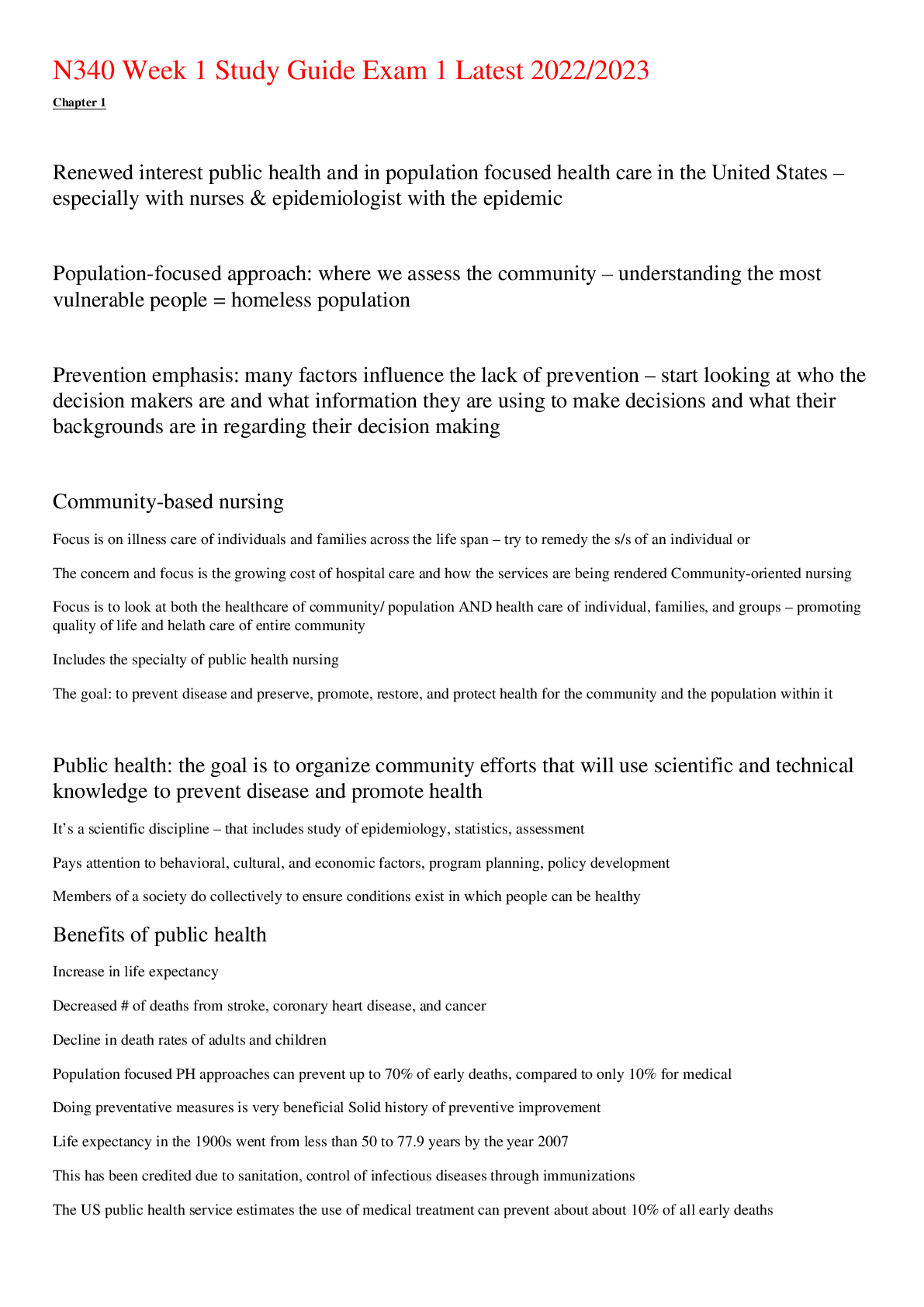
Reviews( 0 )
Document information
Connected school, study & course
About the document
Uploaded On
Feb 27, 2023
Number of pages
16
Written in
Additional information
This document has been written for:
Uploaded
Feb 27, 2023
Downloads
0
Views
31



















